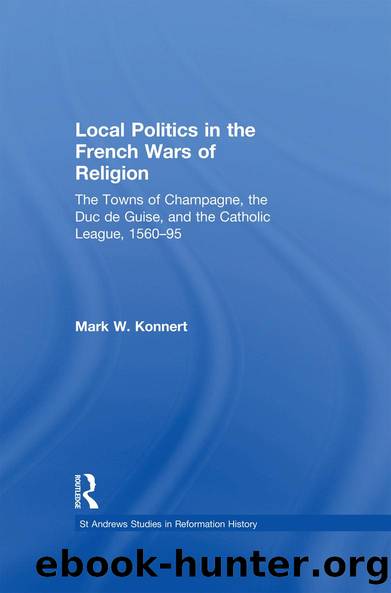Local Politics in the French Wars of Religion by Mark W. Konnert

Author:Mark W. Konnert [Konnert, Mark W.]
Language: eng
Format: epub
Tags: History, General
ISBN: 9781351921589
Google: gGymDwAAQBAJ
Publisher: Routledge
Published: 2017-05-15T04:54:19+00:00
CHAPTER SIX
Authority contested Royal power, the duc de Guise, the Catholic League and the towns of Champagne, 1580â1585
On 10 June 1584, François, duc dâAnjou, younger brother of King Henri III and heir apparent to the throne died in the champenois city of Château-Thierry, which formed part of his appanage. His death constituted a turning point in the Wars of Religion comparable only to the St Bartholomewâs Massacres twelve years earlier. All at once, political calculations and alliances were thrown into turmoil and confusion, for the new heir apparent was the Huguenot leader Henri de Bourbon, king of Navarre. For one thing, Anjouâs death completely reversed the political thinking of the Huguenots and of zealous Catholics. After the bloody events of 1572, Huguenot leaders and writers had developed political theories which justified resistance to and rebellion against a wicked or tyrannical ruler, while Catholics insisted on loyalty to a divinely-annointed king. Now, faced with the prospect of a Huguenot on the throne, the Protestants insisted on loyalty while many zealous Catholics adopted the previous Huguenot ideas of justified resistance. Even when they did not go so far as to advocate rebellion, most Catholics were deeply troubled by the prospect of a heretical king.
Anjouâs death and the resulting Catholic distress also prompted a renewed Catholic League, in imitation of the moribund leagues of the 1570s. This time, however, the Catholic League had much broader appeal. For one thing, it had a defined goal and raison dâêtre: the exclusion of the Huguenot Navarre from the succession. This galvanized Catholic opinion in ways that the amorphous goals of the earlier leagues could not, as ordinary Catholic laypeople were troubled enough to overcome their objections to the earlier leagues examined above.
Clearly here was an opportunity for the Guises to enhance their power while advancing the zealous Catholic agenda. While it is abundantly clear that the Catholic League of 1584 had genuinely popular roots, it is also clear that Guise leadership provided prestige, organization and overall direction to the movement. As Pierre de lâEstoile wrote, Anjouâs death âheartened the House of Lorraine, for whom his death came at a very opportune time, facilitating and advancing their plans for a League, which henceforth grew stronger as France grew weakerâ.1
The first organizational step was taken in September at a conference held in Nancy under the auspices of the duc de Lorraine, Guiseâs kinsman. Present at this meeting were not only Guise and Lorraine, but Guiseâs brothers the duc de Mayenne and the cardinal de Guise, and a number of more distant relatives: the duc de Nemours, the duc and chevalier dâAumale, the duc dâElbeuf and the duc de MercÅur. In addition, there were a number of familiar Guise supporters: Senecey, Mondreville and de Rosne, who with the death of his patron Anjou had now migrated firmly to the Guise clientèle. Also present was a Norman nobleman, François de Roncherolles, sieur de Menneville, who represented the Charles, cardinal de Bourbon, Navarreâs uncle and the eventual Leaguer candidate for king in place of his heretic nephew.
Download
This site does not store any files on its server. We only index and link to content provided by other sites. Please contact the content providers to delete copyright contents if any and email us, we'll remove relevant links or contents immediately.
The Secret History by Donna Tartt(18857)
The Social Justice Warrior Handbook by Lisa De Pasquale(12143)
Thirteen Reasons Why by Jay Asher(8800)
This Is How You Lose Her by Junot Diaz(6800)
Weapons of Math Destruction by Cathy O'Neil(6151)
Zero to One by Peter Thiel(5691)
Beartown by Fredrik Backman(5603)
The Myth of the Strong Leader by Archie Brown(5429)
The Fire Next Time by James Baldwin(5251)
How Democracies Die by Steven Levitsky & Daniel Ziblatt(5132)
Promise Me, Dad by Joe Biden(5088)
Stone's Rules by Roger Stone(5027)
A Higher Loyalty: Truth, Lies, and Leadership by James Comey(4851)
100 Deadly Skills by Clint Emerson(4845)
Rise and Kill First by Ronen Bergman(4705)
Secrecy World by Jake Bernstein(4652)
The David Icke Guide to the Global Conspiracy (and how to end it) by David Icke(4629)
The Farm by Tom Rob Smith(4442)
The Doomsday Machine by Daniel Ellsberg(4420)
